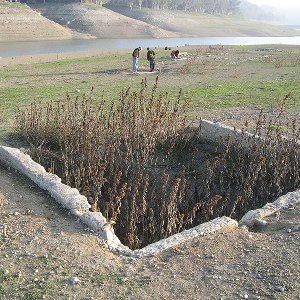Lexington
Lexington is one of several boom-and-bust towns that have come and gone in the Santa Cruz mountains. In the 1800s, several small towns sprang up along the stops of the stagecoach route that ran out of Santa Clara County and through the Santa Cruz mountains, Lexington included. Once a logging town, Lexington was home to a modest population before residents began clearing out in the 1880s, when railroad tracks that bypassed Lexington were laid to replace the stagecoach route.
Alma
Considered a “sister city” to Lexington, Alma was just south of Lexington, but survived well into the 1950s. Its site is also submerged under the Lexington Reservoir, and during drier seasons or droughts, building foundations, a well-preserved pedestrian bridge and even sidewalks are sometimes visible.
 Drawbridge
Drawbridge
Probably the most famous abandoned site in the valley, the textbook ghost town of Drawbridge began life as a lonely outpost along the South Pacific Coast Railroad, where the operator of the town’s two drawbridges hung out. Eventually it became a popular hunting spot, home to a couple of gun clubs and hotels, and developed into a small town. The last resident is said to have left around 1979, and these days it’s an urban explorer’s paradise. Photographers and adventure-seekers regularly make the trek out to the ruins, though it’s officially off-limits to the general public due to unstable soil and mud, slowly submerging the many abandoned structures as time goes on.
 Holy City
Holy City
Founded by cult leader William E. Riker in 1919, Holy City, now buried deep in the Santa Cruz mountains, was to be a commune for followers of The Perfect Divine Christian Way, Riker’s religion that, even for the 1920s, promoted some very questionable ideologies. Over the years, Riker molded Holy City into a roadside oddity and tourist attraction along Old Santa Cruz Highway to pay the bills, but when Highway 17 was constructed, it bypassed the grounds entirely. Riker lost control of the property in 1960 and shortly thereafter, a surge of mysterious fires burned most of the buildings to the ground. All that remains is Riker’s home and the post office, which is now an artist’s shop.
 Wrights
Wrights
Another stop along the South Pacific Coast Railroad, Wrights follows the same old story: it began as a simple stop along the South Coast Pacific Railroad and later burgeoned as logging and agricultural businesses developed in the town to take advantage of the nearby railroad. But when Highway 17 replaced the railroad in the ‘40s, it bypassed Wrights, leaving it cut off from society. Now, a Christmas tree farm stands where Wrights once stood. Some building foundations and the ruins of a railroad tunnel remain in the woods.
 Patchen
Patchen
Patchen would be another business-as-usual Santa Cruz mountain town if it weren’t for Mountain Charley. The near-mythological mountain man who lends his name to a road and a bar in the Los Gatos area was one of the earliest-known settlers in the Santa Cruz mountains. “Mountain” Charley McKiernan’s life evolved into something of a tall tale; he’s best known for muscling through a gruesome bear attack and an even more gruesome operation to fix the hole the bear left in his head, and also for successfully catching and turning in a highwayman that held up a stagecoach that was passing through Patchen. In the years after Mountain Charley’s demise, Patchen became a favorite weekend-getaway town for San Joseans, but began to dwindle when Highway 17 was built and left the small town isolated. A Christmas tree farm now covers the area where Patchen once stood.
 New Almaden
New Almaden
While not strictly a ghost town (people still live there), New Almaden is host to some of the best-kept ruins in the valley. Hidden within the wilds of the Almaden Quicksilver County Park are what’s left of the old Quicksilver mine, and in an unusual turn of fate, it’s actually open to the public… sort of. The more hazardous ones are boarded up, but some are clearly visible and even approachable along the hiking trails that wind through the park.
 Coyote
Coyote
Like New Almaden, Coyote isn’t completely cleared out, so don’t show up expecting to bust any ghosts. Coyote is near populated suburban areas and outlet-shopping meccas like Morgan Hill and Gilroy, but it feels frozen in time. Comfortable homes co-exist with decaying structures from the town’s industrial past. Thanks to its serene, otherworldly aura and convenient location just outside of south San Jose, Coyote is now a popular bike-riding destination.
 Bell Station
Bell Station
Most San Joseans have probably been to Bell Station, but they just don’t know it. It’s more familiar as “that restaurant on the way to Disneyland.” Bell Station was never really a town, just a toll road and a saloon near Pacheco Pass. Somewhere along the way, the Bell Station Restaurant was established to feed hungry travelers; it’s the last outpost of civilization along 152-E for a good long while. Bell Station is in the furthest reaches of Santa Clara County and today it’s deserted, though there was never much to see there in the first place.
 Purissima
Purissima
One of the earliest settlements along the San Mateo coast, Purissima was settled by a German immigrant family, the Dobbels. Already considered a ghost town by the late ‘30s, Purissima was never able to become more than a very sparsely-populated small town. The only thing that remains of Purissima, which once had small-town staples like a schoolhouse and a post office, is the village cemetery, which is far off most main roads and hopelessly tangled in years of overgrowth.



